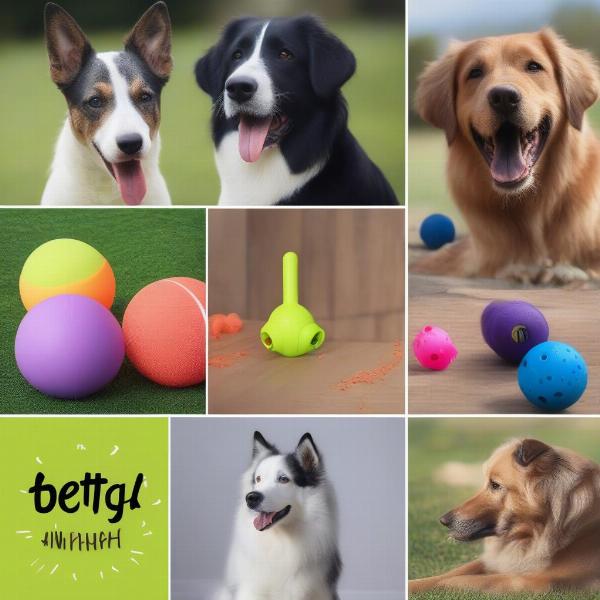Dogs fetch. It’s almost as synonymous with “dog” as barking or tail-wagging. But why do dogs love this seemingly simple game, and how can you teach your furry friend to become a fetching master? This article will delve into the world of dogs and fetching, covering everything from the instinctual roots of the behavior to tips and tricks for training, suitable toys, and addressing common fetching challenges.
The Instinct Behind the Fetch
Why do dogs fetch? For many breeds, especially retrievers, the answer lies in their DNA. Centuries of selective breeding have honed their natural retrieving instincts. Originally bred to retrieve game for hunters, these dogs possess a strong desire to carry objects in their mouths and bring them back to their owners. This isn’t limited to retrievers, though. Many other breeds also enjoy a good game of fetch, even if their motivation isn’t as deeply ingrained. The act of chasing, catching, and returning a toy taps into a dog’s prey drive, providing a healthy outlet for their energy and natural instincts. This can be especially beneficial for high-energy breeds prone to boredom and destructive behaviors.
Teaching Your Dog to Fetch
Not all dogs are natural retrievers, but with patience and positive reinforcement, most can learn to enjoy the game. Start with a toy your dog finds appealing, like a soft, plush toy or a tennis ball. Introduce the toy and encourage your dog to take it in their mouth. If they do, reward them with praise and a treat. Gradually increase the distance you throw the toy, rewarding each successful retrieve. If your dog doesn’t naturally bring the toy back, use a long leash to gently guide them back to you while encouraging them verbally. Remember to keep the training sessions short and fun, and always end on a positive note.
Choosing the Right Fetch Toys
 Best Fetch Toys for Dogs
Best Fetch Toys for Dogs
The right fetch toy can make all the difference in your dog’s enjoyment and safety. Choose toys that are appropriately sized for your dog’s breed and age. Avoid toys that are too small, as they can be a choking hazard. Durable toys are essential, especially for dogs who are enthusiastic chewers. Consider materials like rubber, nylon, or canvas. dogs fetching toy are designed for safe and fun fetching sessions. For dogs who love to chase, chuckit balls for dogs can be a great option, allowing you to throw the ball further with a specialized launcher. If your dog is a soccer fan, an indestructible soccer ball for dogs can provide hours of fun. chuckit toys for dogs offer a variety of shapes and sizes. Lastly, for aerodynamic fun, consider a best frisbee for dogs
Troubleshooting Common Fetching Challenges
Some dogs may be hesitant to fetch, or they may develop bad habits like dropping the toy before returning it. Addressing these challenges requires patience and consistency. If your dog is hesitant, try using a higher-value reward, like a small piece of cooked chicken or cheese. If they drop the toy, practice shorter retrieves and gradually increase the distance. Ensure you reward them only when they bring the toy all the way back to you.
Conclusion
Dogs fetch for a variety of reasons, from instinct to pure enjoyment. By understanding the motivations behind this behavior, and by using positive reinforcement and appropriate toys, you can help your furry friend develop a love for this classic game, providing them with a healthy outlet for their energy and strengthening the bond between you.
FAQ
- Why does my dog not fetch? Some dogs aren’t naturally inclined to fetch. Patience and positive reinforcement are key to teaching them.
- What are the best toys for fetching? Durable toys made of rubber, nylon, or canvas are ideal. Consider your dog’s size and chewing habits.
- How do I teach my dog to bring the toy back? Use a long leash to gently guide them back while encouraging them verbally.
- Why does my dog drop the toy before reaching me? Practice shorter retrieves and reward them only when they bring the toy all the way back.
- What if my dog is more interested in chewing the toy than fetching it? Try a different type of toy or redirect their chewing behavior to an appropriate chew toy.
- How often should I play fetch with my dog? Adjust the frequency based on your dog’s age, breed, and energy levels.
- Can I play fetch with a senior dog? Yes, but adjust the intensity and duration of the game to suit their physical limitations.
About ILM Dog
ILM Dog (https://ilmdog.com) is your trusted international resource for all things dog-related. We provide expert advice on dog breeds, health, training, nutrition, grooming, and much more. Whether you’re a new dog owner or a seasoned expert, we offer practical tips and valuable insights to help you provide the best possible care for your canine companion. We cover various areas of expertise, including dog breeds and selection, health and medical care, training and behavior, nutrition and feeding, grooming and hygiene, and products and accessories. For inquiries, contact us via email at [email protected] or by phone at +44 20-3965-8624.